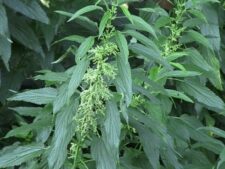
This native perennial grows to be an erect plant to 6 feet and taller. The square stem and leaves are covered with stinging hairs. The lance-shaped leaves are on long stalks and opposite on the stems (B). The tiny green flowers are on branching and spreading clusters from the upper leaf axils (A). Male and female flowers may or may not be on the same plant. Identified by the stinging hairs and drooping and spreading flower clusters. The similar False Nettle (Boehmeria cylindrica) has flower clusters on erect spikes and lacks the stinging hairs.
Found in ravines and other moist areas, flowering from June through September. In Fontenelle Forest, common, for instance in Mormon Hollow. At Neale Woods, common in Raccoon Hollow and along MRE Trail.
Local Native Americans used the fiber from this plant to make twine and cordage. Rope from this fiber was used to hobble horses. The tip of each tiny hair is broken off when touched, allowing a histamine-like stinging agent to ooze out. This is our most irritating nettle.
The content of NatureSearch is provided by dedicated volunteer Naturalists of Fontenelle Forest who strive to provide the most accurate information available. Contributors of the images retain their copyrights. The point of contact for this page is: Roland Barth.

